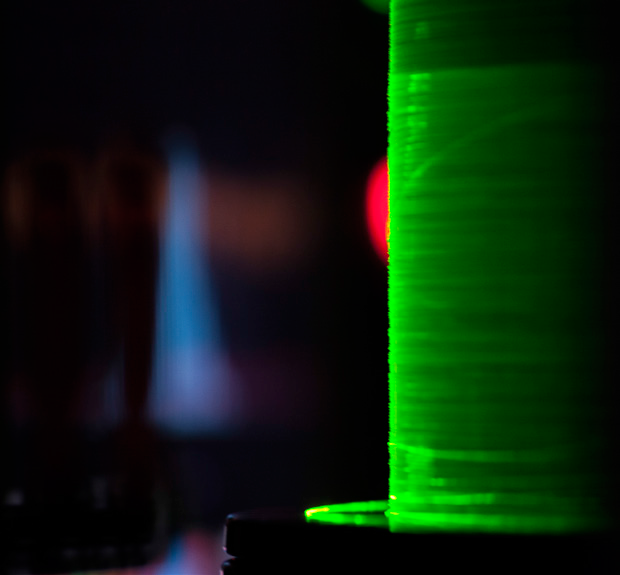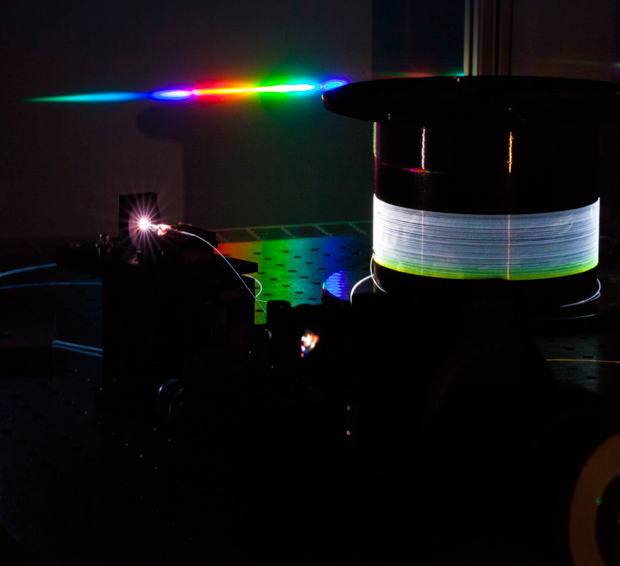From springs to lasers: energy’s mysterious cycle
In 1953, scientists theorized the energy behavior of a chain of springs and revealed a paradox in fundamental physics. Over 60 years later, a group of researchers from IMT Lille Douai, CNRS and the universities of Lille and Ferrara (Italy) has succeeded in observing this paradox. Their results have greatly enhanced our understanding of physical nonlinear systems, which are the basic ingredients required for detecting exoplanets, navigating driverless cars and the formation of big waves in the ocean. Arnaud Mussot, a physicist and member of the partnership, explains the process and the implications of the research, published in Nature Photonics on April 2, 2018.
The starting point for your work was the Fermi-Pasta-Ulam-Tsingou problem. What is that?
Arnaud Mussot: The name refers to the four researchers who wanted to study a complex problem in the 1950s. They were interested in observing the behavior of masses connected by springs. They used 64 of them in their experiment. With a chain like this, each spring’s behavior depends on that of the others, but in a non-proportional manner – what we call “nonlinear” in physics. A theoretical study of the nonlinear behavior of such a large system of springs required them to use a computer. They thought that the theoretical results the computer produced would show that when one spring is agitated, all the springs begin to vibrate until the energy spreads evenly to the 64 springs.
Is that what happened?
AM: No. To their surprise, the energy spread throughout the system and then returned to the initial spring. It was then redispersed into the springs and then again returned to the initial point of agitation, and so on. These results from the computer completely contradicted their prediction of energy being evenly and progressively distributed, known as an equipartition of energy. Since then, these results have been called the “Fermi-Pasta-Ulam-Tsingou paradox” or “Fermi-Pasta-Ulam-Tsingou recurrence”, referring to the recurring behavior of the system of springs. However, since the 1950s, other theoretical research has been carried out. This research has shown that by allowing a system of springs to vibrate for a very long time, equipartition is achieved.
Why is the work you refer to primarily theoretical and not experimental?
AM: In reality, the vibrations in the springs are absorbed by many external factors. It could be friction with the air. In fact, experiments carried out to observe this paradox have not only concerned springs, but all nonlinear oscillation systems, such as laser beams in fiber optics. In this case, the vibrations are mainly absorbed by impurities in the glass that composes the fiber. In all these systems, energy losses due to external factors prevent the observation of anything beyond the first recurrence. The system returns to its initial state, but then it is difficult to make it return to this state a second time. Yet it is in this step that new and rich physics emerge.
Is this where your work published in Nature Photonics on April 2nd comes into play?
AM: We thought it was a shame to be limited to a single recurrence, because many interesting things happen when we can observe at least two. We therefore had to find ways to limit the absorption of the vibrations in order to reach the second recurrence. To accomplish this, we added a second laser which amplified the first one to compensate for the losses. This type of amplification is already used in fiber optics to carry data over long distances. We distorted its initial purpose to resolve part of our problem. The other part was to succeed in observing the recurrence.

Whether it be a spring or an optical fiber, Fermi-Pasta-Ulam-Tsingou recurrence is common to all nonlinear system
Was the observation difficult to achieve?
AM: Compensating for energy losses was a crucial step, but it was pointless if we were not able to clearly observe what was happening in the fiber. To achieve this, we used the same impurities in the glass which absorbed the light signal. These impurities reflect a small part of the laser which circulates in the fiber. The returning light provides us with information on the development of the laser beam’s power as it spreads. This reflected part is then measured with another laser which is synchronous with the first, to assess the difference in phase between the two. This gives us additional information that allows us to clearly reveal the second recurrence for the first time in the world.
What did these observation techniques reveal about the second recurrence?
AM: We were able to conduct the first experimental demonstration involving what we call a break in symmetry. There is a recurrence for the data values of the initial energy sent into the system. But we also knew that theoretically, if we slightly changed these initial values that disturbed the system, there would be a shift in the distribution of energy during the second recurrence. The system did not repeat the same values. In our experiment, we managed to reverse the maximum and minimum energy level in the second recurrence compared to the first.
What perspectives does this observation create?
AM: From a fundamental perspective, the experimental observation of the theory predicting the break in symmetry is very interesting because it provides a confirmation. But in addition to this, the techniques we implemented to limit the absorption and observe what was occurring are very promising. We want to perfect them in order to go beyond second recurrence. If we succeed in reaching the equipartition point predicted by Fermi, Pasta, Ulam and Tsingou, we will then be able to observe a continuum of light. In very simple terms, this is the moment when we no longer see the lasers’ pulsations.
Does this fundamental work have applications?
AM: In terms of applications, our work allowed us to better understand how nonlinear systems develop. Yet these systems are often all around us. In nature for example, they are the basic ingredients for forming rogue waves, exceptionally high waves that can be observed in the ocean. With a better understanding of Fermi-Pasta-Ulam-Tsingou recurrence and the energy variations in nonlinear systems, we could better understand the mechanisms involved in shaping rogue waves and could better detect them. Nonlinear systems are also present in many optical tools. Modern LIDARs which use frequency combs, or “laser rulers’’ calculate the distances by sending a laser beam and then very precisely timing how long it takes for it to return—like a radar except with light. However, the lasers have nonlinear behavior: here again our work can help optimize the operation of new generation LIDARs, which could be used for navigating autonomous cars. Finally, calculations on the physical nonlinear systems are also involved in detecting exoplanets, thanks to their extreme precision.





Leave a Reply
Want to join the discussion?Feel free to contribute!